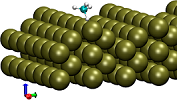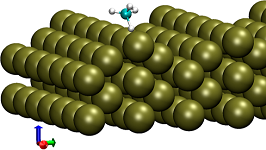Accueil > Équipes scientifiques > Surfaces, Interfaces, Molecules & 2D Materials (SIM2D) > Calculs de structures électriques et dynamique quantique moléculaire sur des surfaces métalliques
Calculs de structures électriques
Calculs de structures électriques et dynamique quantique moléculaire sur des surfaces métalliques
 Leader : Sven Nave
Leader : Sven Nave
Nos études portent sur la dynamique et la réactivité des atomes et des molécules en phase gazeuse ou en interaction avec des surfaces. Notre objectif est d’obtenir des probabilités de réaction, de déterminer la répartition de l’énergie entre la surface, le mouvement de translation et les degrés de liberté internes des produits, de caractériser l’effet de surface sur les réactions chimiques. Ces études sont développées dans le contexte des nanosciences.
Highlights
 Dissociative Chemisorption of Methane on Ni and Pt Surfaces : Mode-Specific Chemistry and the Effects of Lattice Motion Dissociative Chemisorption of Methane on Ni and Pt Surfaces : Mode-Specific Chemistry and the Effects of Lattice Motion
The dissociative chemisorption of methane on metal surfaces is of great practical and fundamental interest. Not only is it the rate-limiting step in the steam reforming of natural gas, but also the reaction exhibits interesting mode-specific behavior and a strong dependence on the temperature of the metal. Electronic structure methods are used to explore this reaction on various Ni and Pt surfaces, with a focus on how the transition state is modified by motion of the metal lattice atoms. These results are used to construct models that explain the strong variation in reactivity with substrate temperature, shown to result primarily from changes in the dissociation barrier height with lattice motion. The dynamics of the dissociative chemisorption of CH4 on Ni and Pt is explored, using a fully quantum approach based on the reaction path Hamiltonian that includes all 15 molecular degrees of freedom and the effects of lattice motion. Agreement with experiment is good, and vibrational excitation of the molecule is shown to significantly enhance reactivity. The efficacy for this is examined in terms of the vibrationally nonadiabatic couplings, mode softening, mode symmetry, and energy localization in the reactive bond. |
Article : S. Nave, A. K. Tiwari, B. Jackson, "Dissociative Chemisorption of Methane on Ni and Pt Surfaces : Mode-Specific Chemistry and the Effects of Lattice Motion", J. Phys. Chem. A 118, 9615−9631 (2014)


